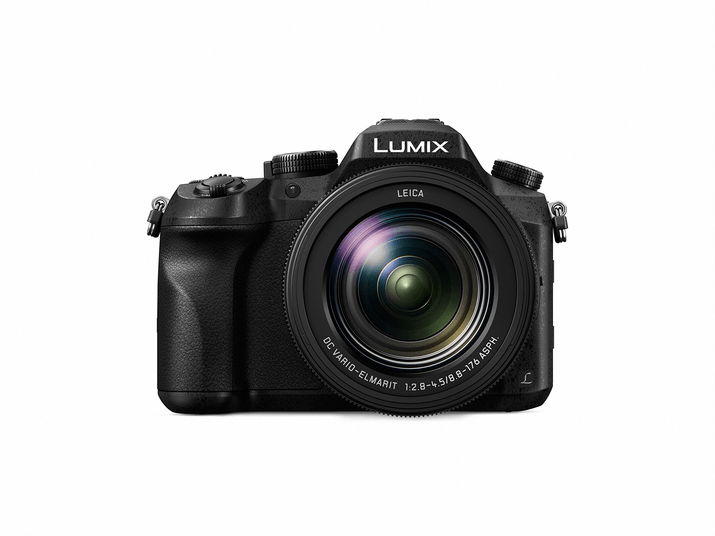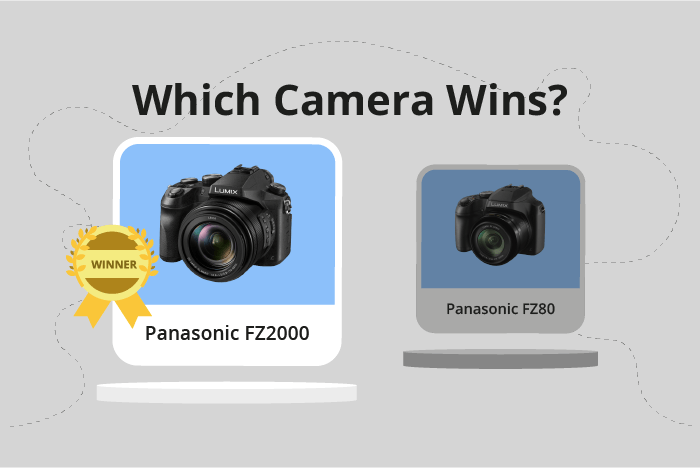Panasonic Lumix DMC-FZ2000 / FZ2500 vs Lumix FZ80 / FZ82 Comparison
Panasonic Lumix DMC-FZ2000 / FZ2500

Panasonic Lumix FZ80D

The Panasonic Lumix DMC-FZ2000 / FZ2500 outperforms the Panasonic Lumix FZ80 / FZ82 with a score of 63/100 compared to 54/100. Both cameras are bridge type and were announced in 2016 and 2017, respectively. They share similarities in their design and camera type.
The FZ2000 / FZ2500 boasts a higher score due to its better overall specifications. It has a larger size (138 x 102 x 135mm) and heavier weight (915g / 2.02lbs), which may contribute to its superior performance. However, it comes with a higher launch price of $1199.
On the other hand, the FZ80 / FZ82 is more affordable with a launch price of $399.99 and has a more compact size (130 x 94 x 119mm) and lighter weight (616g / 1.36lbs). These factors make it a more budget-friendly and portable option.
Taking these points into consideration, the FZ2000 / FZ2500 is the better camera in terms of performance, while the FZ80 / FZ82 offers a more budget-friendly and portable alternative.
Panasonic Lumix DMC-FZ2000 / FZ2500 vs Lumix FZ80 / FZ82 Overview and Optics
The Panasonic Lumix DMC-FZ2000 / FZ2500 outperforms the Panasonic Lumix FZ80 / FZ82 in optics with a score of 62/100 compared to 48/100. Both cameras share common specifications such as a CMOS sensor, Venus Engine processor, fixed lens mount, and image stabilization, which contribute to their overall performance.
The FZ2000 / FZ2500 is superior in several ways. It has a higher megapixel count at 20, allowing for greater image resolution and detail. The shooting speed of 12 frames per second is faster than the FZ80 / FZ82’s 10 frames per second, enabling better capture of fast-moving subjects. Additionally, the FZ2000 / FZ2500 features a larger 1″ sensor size, which improves low light performance and delivers a shallower depth of field, compared to the FZ80 / FZ82’s smaller 1/2.3″ sensor.
On the other hand, the FZ80 / FZ82 holds a slight advantage in its DXOMARK sensor score of 71, one point higher than the FZ2000 / FZ2500’s score of 70. This difference, however, is minimal and may not greatly impact image quality. The FZ80 / FZ82 also has a different aspect ratio of 4:3, compared to the FZ2000 / FZ2500’s 3:2, which might be preferred by some users but is largely a matter of personal preference.
Considering the overall comparison, the Panasonic Lumix DMC-FZ2000 / FZ2500 emerges as the better option for those seeking higher image quality and performance in optics. While the Panasonic Lumix FZ80 / FZ82 has a slightly higher DXOMARK sensor score and a different aspect ratio, these factors are not enough to outweigh the advantages provided by the FZ2000 / FZ2500.
Panasonic Lumix DMC-FZ2000 / FZ2500 vs Lumix FZ80 / FZ82 Video Performance
The Panasonic Lumix FZ80 / FZ82 outperforms the Panasonic Lumix DMC-FZ2000 / FZ2500 in video capabilities, with a score of 83 out of 100 compared to the latter’s 69. Both cameras share 4K video resolution, maximum video frame rate of 60fps, and the ability to capture stunning video footage. However, there are specific factors that make the FZ80 / FZ82 a superior choice for video recording.
The FZ80 / FZ82 has time-lapse functionality built in, a feature not found in the FZ2000 / FZ2500. Time-lapse is a popular and creative technique that can enhance video projects, making this a significant advantage for the FZ80 / FZ82. Additionally, the FZ80 / FZ82 has a higher video score, reflecting its overall better video performance.
On the other hand, the FZ2000 / FZ2500 has slightly larger video dimensions, at 4096 x 2160, compared to the FZ80 / FZ82’s 3840 x 2160. This difference in dimensions may give the FZ2000 / FZ2500 a slight edge in terms of video quality.
Considering these factors, the Panasonic Lumix FZ80 / FZ82 is the better option for video capabilities, thanks to its built-in time-lapse functionality and higher video score. Although the FZ2000 / FZ2500 has larger video dimensions, it lacks the time-lapse feature and falls short in overall video performance. Therefore, the FZ80 / FZ82 is the recommended choice for those seeking a camera with superior video capabilities.
Panasonic Lumix DMC-FZ2000 / FZ2500 vs Lumix FZ80 / FZ82 Features and Benefits
The Panasonic Lumix DMC-FZ2000/FZ2500 and the Panasonic Lumix FZ80/FZ82 have identical feature scores, with both cameras achieving 70 out of 100 points. This indicates that they share many similarities in terms of functionality and features.
Both cameras have 3-inch touchscreens with a resolution of 1,040,000 dots, providing clear and sharp visuals. They also have WiFi and Bluetooth capabilities, allowing for easy sharing and transferring of images and videos. Additionally, neither camera has GPS functionality.
The Lumix DMC-FZ2000/FZ2500 outperforms the FZ80/FZ82 in terms of having a flip screen, which allows for greater flexibility in shooting angles and better composition. This feature is particularly useful for vlogging, self-portraits, and capturing images from challenging angles.
The FZ80/FZ82, on the other hand, lacks a flip screen, which may limit its versatility in certain shooting scenarios. However, it is important to consider the specific needs of the user when evaluating this feature. Some photographers may not require a flip screen, and therefore, this limitation may not impact their experience with the FZ80/FZ82.
In conclusion, both the Panasonic Lumix DMC-FZ2000/FZ2500 and the Panasonic Lumix FZ80/FZ82 offer a range of features that cater to a variety of photography needs. The main difference between the two cameras lies in the presence of a flip screen on the FZ2000/FZ2500, which may be a deciding factor for some users. Ultimately, the choice between these two cameras depends on the individual’s preferences and requirements.
Panasonic Lumix DMC-FZ2000 / FZ2500 vs Lumix FZ80 / FZ82 Storage and Battery
The Panasonic Lumix DMC-FZ2000 / FZ2500 and the Panasonic Lumix FZ80 / FZ82 tie in storage and battery score, both receiving 35/100 points. Both cameras have one memory card slot and accept SD, SDHC, and SDXC memory cards. They also both offer USB charging capabilities.
The FZ2000 / FZ2500 has a slight advantage in battery life, providing 350 shots per charge compared to the FZ80 / FZ82’s 330 shots. This difference in battery life is due to the FZ2000 / FZ2500 using the DMW-BLC12 battery type, while the FZ80 / FZ82 uses the DMW-BMB9 battery type.
Despite the FZ2000 / FZ2500’s marginally better battery life, the FZ80 / FZ82 does not have any notable advantages in the storage and battery category. Both cameras perform similarly in this aspect, with neither significantly outperforming the other.
Considering the storage and battery aspects of these cameras, the Panasonic Lumix DMC-FZ2000 / FZ2500 holds a minor edge over the Panasonic Lumix FZ80 / FZ82 due to its longer battery life. However, this difference is minimal, and both cameras are quite comparable in terms of storage and battery performance.
Panasonic Lumix DMC-FZ2000 / FZ2500 vs Lumix FZ80 / FZ82 – Our Verdict
Are you still undecided about which camera is right for you? Have a look at these popular comparisons that feature the Panasonic Lumix DMC-FZ2000 / FZ2500 or the Panasonic Lumix FZ80 / FZ82:
- Panasonic Lumix DMC-FZ1000 II vs Lumix DMC-FZ2000 / FZ2500
- Panasonic Lumix FZ300 / FZ330 vs Lumix FZ80 / FZ82
- Panasonic Lumix DMC-FZ2000 / FZ2500 vs Lumix FZ300 / FZ330
- Canon PowerShot SX70 HS vs Panasonic Lumix DMC-FZ2000 / FZ2500
- Nikon Coolpix P950 vs Panasonic Lumix DMC-FZ2000 / FZ2500
- Panasonic Lumix DMC-FZ2000 / FZ2500 vs Sony Cyber-shot RX10 IV

